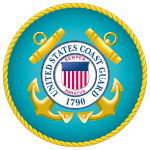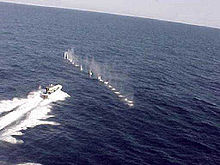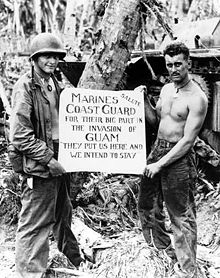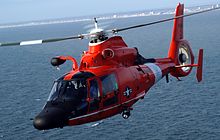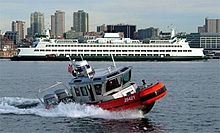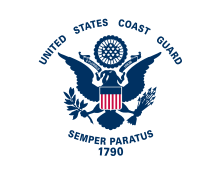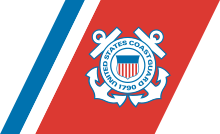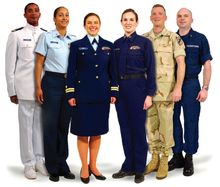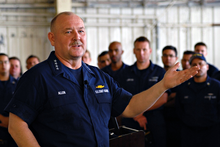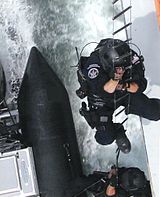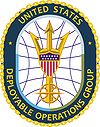- United States Coast Guard
-
United States Coast Guard
United States Coast Guard portalActive 4 August 1790–present Country  United States
United StatesType Coast Guard Size Civilian employees: 7,057
Active duty personnel: 41,873
Selected Reservists: 8,100
Auxiliary: 30,000
244 cutters, 1,850 boats, 204 aircraft [1][2]Part of Department of Homeland Security Motto Semper Paratus Colors White, CG Blue, CG Red[3] March Semper Paratus Engagements Quasi-War
War of 1812
Seminole Wars
Mexican-American War
American Civil War
Spanish American War
World War I
World War II
Korean War
Vietnam War
Gulf War
Operation Iraqi Freedom
Afghanistan War
Operation Sea Dragon III
War on Terror
Anti-piracyDecorations Presidential Unit Citation Commanders Commandant ADM Robert J. Papp, Jr. Vice Commandant VADM Sally Brice-O'Hara Master Chief Petty Officer MCPOCG Michael P. Leavitt Insignia Racing Stripe 
Ensign 
Standard 
Aircraft flown Helicopter HH / MH-60 J/T Jayhawk HH / MH-65 C/D Dolphin
Patrol HC-130 H/J Hercules HC-144A Ocean Sentry
Transport VC-37A Long Range VIP Aircraft The United States Coast Guard (USCG) is a branch of the United States Armed Forces and one of the seven U.S. uniformed services. The Coast Guard is a maritime, military, multi-mission service unique among the military branches for having a maritime law enforcement mission (with jurisdiction in both domestic and international waters) and a federal regulatory agency mission as part of its mission set. It operates under the Department of Homeland Security during peacetime, and can be transferred to the Department of the Navy by the President at any time, or by Congress during time of war.
Founded by Alexander Hamilton as the Revenue Cutter Service on 4 August 1790, it lays claim to being the United States' oldest continuous seagoing service. As of August 2009, the Coast Guard had approximately 42,000 men and women on active duty, 7,500 reservists, 30,000 auxiliarists, and 7,700 full-time civilian employees.[4]
The Coast Guard's legal authority differs from the other four armed services and it operates simultaneously under Title 10 of the United States Code and its other organic authorities, e.g., Titles 6, 14, 19, 33, 46, etc. Because of its legal authority, the Coast Guard can conduct military operations under the Department of Defense or directly for the President in accordance with Title 14 USC 1–3.
The Coast Guard's enduring roles are Maritime Safety, Maritime Security, and Maritime Stewardship. To carry out those roles the Coast Guard has eleven statutory missions as defined in .
The Coast Guard motto is "Semper Paratus", Latin for "Always Ready" or "Always Prepared".
Mission
Role
 A boatswain’s mate watches from the side port door as Coast Guard Cutter Bertholf’s Over-The-Horizon small boat departs to receive personnel from Coast Guard Cutter Chandeleur.
A boatswain’s mate watches from the side port door as Coast Guard Cutter Bertholf’s Over-The-Horizon small boat departs to receive personnel from Coast Guard Cutter Chandeleur.
The Coast Guard has roles in maritime homeland security, maritime law enforcement (MLE), search and rescue (SAR), marine environmental protection (MEP), and the maintenance of river, intracoastal and offshore aids to navigation (ATON).
While most military services are either at war or training for war, the Coast Guard is deployed every day. With a decentralized organization and much responsibility placed on even the most junior personnel, the Coast Guard is frequently lauded for its quick responsiveness and adaptability in a broad range of emergencies. In a 2005 article in TIME magazine following Hurricane Katrina, the author wrote, "the Coast Guard's most valuable contribution to [a military effort when catastrophe hits] may be as a model of flexibility, and most of all, spirit." Wil Milam, a rescue swimmer from Alaska told the magazine, "In the Navy, it was all about the mission. Practicing for war, training for war. In the Coast Guard, it was, take care of our people and the mission will take care of itself."[5]
Missions
The Coast Guard carries out three basic roles, which are further subdivided into eleven statutory missions. The three roles are:
- Maritime safety
- Maritime security
- Maritime stewardship
The eleven statutory missions as defined by law are divided into homeland security missions and non-homeland security missions:[6]
Non-homeland security missions
- Marine safety
- Search and rescue
- Aids to navigation
- Living marine resources (fisheries law enforcement)
- Marine environmental protection
- Ice operations
Homeland security missions
- Ports, waterways and coastal security (PWCS)
- Drug interdiction
- Migrant interdiction
- Defense readiness
- Other law enforcement
Search and Rescue
 Search and Rescue Program Logo of the United States Coast Guard.
Search and Rescue Program Logo of the United States Coast Guard.
While not the oldest, search and rescue (SAR) is one of the Coast Guard's best known missions. The National Search and Rescue Plan[7] designates the Coast Guard as the federal agency responsible for maritime SAR operations, and the United States Air Force as the federal agency responsible for inland SAR. Both agencies maintain rescue coordination centers to coordinate this effort, and have responsibility for both military and civilian search and rescue.
National Response Center
Operated by the Coast Guard, the National Response Center (NRC) is the sole U.S. Government point of contact for reporting all oil, chemical, radiological, biological, and etiological discharges into the environment anywhere in the United States and its territories. In addition to gathering and distributing spill data for Federal On Scene Coordinators and serving as the communications and operations center for the National Response Team, the NRC maintains agreements with a variety of federal entities to make additional notifications regarding incidents meeting established trigger criteria. The NRC also takes Terrorist/Suspicious Activity Reports and Maritime Security Breach Reports. Details on the NRC organization and specific responsibilities can be found in the National Oil and Hazardous Substances Pollution Contingency Plan.[8] The Marine Information for Safety and Law Enforcement (MISLE) database system is managed and used by the United States Coast Guard (USCG)for tracking pollution and safety incidents in the nation's ports.
Authority as an armed service
The five uniformed services that make up the Armed Forces are defined in :
The term "armed forces" means the Army, Navy, Air Force, Marine Corps, and Coast Guard.
The Coast Guard is further defined by :
The Coast Guard as established 28 January 1915, shall be a military service and a branch of the armed forces of the United States at all times. The Coast Guard shall be a service in the Department of Homeland Security, except when operating as a service in the Navy.
Coast Guard organization and operation is as set forth in Title 33 of the Code of Federal Regulations.
On 25 February 2003, the Coast Guard was placed under the Department of Homeland Security. The Coast Guard reports directly to the Secretary of Homeland Security. However, under 14 U.S.C. § 3 as amended by section 211 of the Coast Guard and Maritime Transportation Act of 2006, upon the declaration of war and when Congress so directs in the declaration, or when the President directs, the Coast Guard operates under the Department of Defense as a service in the Department of the Navy.
As members of the military, Coast Guardsmen on active and reserve service are subject to the Uniform Code of Military Justice and receive the same pay and allowances as members of the same pay grades in the other uniformed services.
The service has participated in every major U.S. conflict from 1790 through today, including landing troops on D-Day and on the Pacific Islands in World War II, in extensive patrols and shore bombardment during the Vietnam War, and multiple roles in Operation Iraqi Freedom. Maritime interception operations, coastal security, transportation security, and law enforcement detachments have been its major roles in recent conflicts in Iraq.
On 17 October 2007, the Coast Guard joined with the U.S. Navy and U.S. Marine Corps to adopt a new maritime strategy called A Cooperative Strategy for 21st Century Seapower that raised the notion of prevention of war to the same philosophical level as the conduct of war.[9] This new strategy charted a course for the Navy, Coast Guard and Marine Corps to work collectively with each other and international partners to prevent regional crises, manmade or natural, from occurring or reacting quickly should one occur to avoid negative impacts to the United States. During the launch of the new U.S. maritime strategy at the International Seapower Symposium at the U.S. Naval War College in 2007, Coast Guard Commandant Admiral Thad Allen said the new maritime strategy reinforced the time-honored missions the service has carried out in the United States since 1790. "It reinforces the Coast Guard maritime strategy of safety, security and stewardship, and it reflects not only the global reach of our maritime services but the need to integrate and synchronize and act with our coalition and international partners to not only win wars ... but to prevent wars," Allen said.[9]
Authority as a law enforcement agency
14 U.S.C. § 2 authorizes the Coast Guard to enforce federal law. This authority is further defined in 14 U.S.C. § 89, which gives law enforcement powers to all Coast Guard commissioned officers, warrant officers, and petty officers. Unlike the other branches of the United States Armed Forces, which are prevented from acting in a law enforcement capacity by the Posse Comitatus Act and Department of Defense policy, under 18 U.S.C. § 1385 the Coast Guard is exempt from and not subject to the restrictions of the Posse Comitatus Act.
Further law enforcement authority is given by and , which empower U.S. Coast Guard active and reserve commissioned officers, warrant officers, and petty officers as federal customs officers. This places them under , which grants customs officers general law enforcement authority, including the authority to:
(1) carry a firearm;
(2) execute and serve any order, warrant, subpoena, summons, or other process issued under the authority of the United States;
(3) make an arrest without a warrant for any offense against the United States committed in the officer's presence or for a felony, cognizable under the laws of the United States committed outside the officer's presence if the officer has reasonable grounds to believe that the person to be arrested has committed or is committing a felony; and
(4) perform any other law enforcement duty that the Secretary of Homeland Security may designate.The U.S. Government Accountability Office Report to the House of Representatives, Committee on the Judiciary on its 2006 Survey of Federal Civilian Law Enforcement Functions and Authorities, identified the U.S. Coast Guard as one of 104 federal components that employed law enforcement officers.[10] The report also included a summary table of the authorities of the U.S. Coast Guard's 192 special agents and 3,780 maritime law enforcement boarding officers.[11]
Coast Guardsmen have the legal authority to carry their service-issued firearms on and off base. This is rarely done in practice, however; at many Coast Guard stations, commanders prefer to have all service-issued weapons in armories. Still, one court has held that Coast Guard boarding officers are qualified law enforcement officers authorized to carry personal firearms off-duty for self-defense.[12]
History
The roots of the Coast Guard lie in the United States Revenue Cutter Service established by Alexander Hamilton under the Department of the Treasury on 4 August 1790. The first Coast Guard station was in Newburyport, Massachusetts. Until the re-establishment of the United States Navy in 1798, the Revenue Cutter Service was the only naval force of the early United States. It was established to collect taxes from a brand new nation of patriot smugglers. When the officers were out at sea, they were told to crack down on piracy; while they were at it, they might as well rescue anyone in distress.[13]
"First Fleet" is a term occasionally used as an informal reference to the U.S. Coast Guard, although there is no indication that the United States has ever officially used this designation with reference either to the Coast Guard or any element of the U.S. Navy. The informal appellation honors the fact that between 1790 and 1798, there was no United States Navy and the cutters which were the predecessor of the U.S. Coast Guard were the only warships protecting the coast, trade, and maritime interests of the new republic.[14]
The modern Coast Guard can be said to date to 1915, when the Revenue Cutter Service merged with the United States Life-Saving Service and Congress formalized the existence of the new organization. In 1939, the U.S. Lighthouse Service was brought under its purview. In 1942, the Bureau of Marine Inspection and Navigation was transferred to the Coast Guard. In 1967, the Coast Guard moved from the Department of the Treasury to the newly formed Department of Transportation, an arrangement that lasted until it was placed under the Department of Homeland Security in 2002 as part of legislation designed to more efficiently protect American interests following the terrorist attacks of 11 September 2001.
In times of war, the Coast Guard or individual components of it can operate as a service of the Department of the Navy. This arrangement has a broad historical basis, as the Guard has been involved in wars as diverse as the War of 1812, the Mexican-American War, and the American Civil War, in which the cutter Harriet Lane fired the first naval shots attempting to relieve besieged Fort Sumter. The last time the Coast Guard operated as a whole within the Navy was in World War II. More often, military and combat units within the Coast Guard will operate under Navy or joint operational control while other Coast Guard units will remain under the Department of Homeland Security.
Organization
The current headquarters of the Coast Guard is at 2100 Second Street, SW, in Washington, D.C. near Nationals Park, where it will continue to have a presence at least into 2015.[15] The new Department of Homeland Security headquarters complex is being built on the grounds of the former St. Elizabeths Hospital in the Anacostia section of Southeast Washington, across the Anacostia River from the current Coast Guard headquarters. As part of this consolidation, the Coast Guard will be the first DHS agency to locate its headquarters in the new complex, estimated to occur in late 2013 or early 2014.[16]
Shore establishments
Shore establishment commands exist to support the mission of the seaborne or airborne fleets through the use of facilities on land. The headquarters is in Washington DC. Other shore establishments are Coast Guard Stations, Coast Guard Air Stations, Aids to Navigation Stations and the United States Coast Guard Yard. Training centers include the United States Coast Guard Academy, Training Center Petaluma, Training Center Cape May and Training Center Yorktown.
Personnel
The formal name for a uniformed member of the Coast Guard is "Coast Guardsman", irrespective of gender. "Coastie" is an informal term commonly used to refer to current or former Coast Guard personnel. "Team Coast Guard" refers to the four components of the Coast Guard as a whole: Regular, Reserve, Auxiliary, and Coast Guard civilian employees. In 2008, the term "Guardian" was introduced, but is being phased out of use. Sailor is a term used for the sea-going members of the Coast Guard. Admiral Papp stated that it was his belief that no Commandant had the authority to change what members of the Coast Guard are called as the term Coast Guardsman is found in Title 14 of the USC, which in 1915 established the Coast Guard.[17]
Commissioned Officers
Commissioned officers in the Coast Guard have pay grades ranging from O-1 to O-10, with O-10 being the highest and use the same rank structure as the Navy. Officers holding the rank of Ensign (O-1) through Lieutenant Commander (O-4) are considered junior officers, Commanders (O-5) and Captains (O-6) are considered senior officers, and Rear Admirals (O-7) through Admiral (O-10) are considered flag officers. The Commandant is the only member of the Coast Guard to hold the rank of Admiral.[18]
The Coast Guard does not have medical officers or chaplains. Instead, U.S. Navy chaplains and U.S. Public Health Service Commissioned Corps officers are assigned to the Coast Guard to perform these functions. These officers wear Coast Guard uniforms but replace the Coast Guard insignia with that of their own service.[19]
Commissioned Officer grade structure of the United States Coast Guard Admiral (ADM)
Vice Admiral (VADM)
Rear Admiral [20][21] (RADM)
Rear Admiral
(lower half)(RDML)
Captain (CAPT)
Commander (CDR)
Lieutenant
Commander(LCDR)
Lieutenant (LT)
Lieutenant
(junior grade) [20][21](LTJG)
Ensign (ENS)
O-10 O-9 O-8 O-7 O-6 O-5 O-4 O-3 O-2 O-1 Warrant Officers
Highly qualified enlisted personnel from E-6 through E-9 with a minimum of eight years experience can compete each year for appointment as Warrant Officers (WO). Successful candidates are chosen by a board and then commissioned as Chief Warrant Officers (CWO-2) in one of sixteen specialties. Over time Chief Warrant Officers may be promoted to CWO-3 and CWO-4. The ranks of Warrant Officer (WO-1) and Chief Warrant Officer (CWO-5) are not currently used in the Coast Guard. Chief Warrant Officers may also compete for the Chief Warrant Officer to Lieutenant program. If selected, the officer will be promoted to Lieutenant (O-3E). The "E" designates over four years active duty service as a Warrant Officer or Enlisted member and entitles the member to a higher rate of pay than other Lieutenants.
Warrant Officer grade structure of the United States Coast Guard Chief Warrant Officer 4 Chief Warrant Officer 3 Chief Warrant Officer 2 W-4 W-3 W-2 Enlisted Personnel
Enlisted members of the Coast Guard have pay grades from E-1 to E-9, with E-9 being the highest. All enlisted members with pay grades of E-4 and higher are considered Petty Officers and follow career development paths very similar to those of U.S. Navy petty officers.
Petty officers in pay grade E-7 and higher are named Chief Petty Officers and must attend the Coast Guard Chief Petty Officer Academy, or an equivalent Department of Defense school, in order to be advanced to pay grade E-8. The basic themes of the school are:
- Professionalism
- Leadership
- Communications
- Systems thinking and lifelong learning
Non-commissioned Officer grade structure of the United States Coast Guard[22]
Note: Crossed anchors in the graphics indicate a rating of Boatswain's MateMaster Chief Petty Officer of the Coast Guard (MCPOCG)
Area CMC/Headquarters CMC/MCPOCG (Reserve Forces) Command Master Chief Petty Officer (CMC)
Master Chief Petty Officer (MCPO)
Senior Chief Petty Officer (SCPO)
Chief Petty Officer (CPO)
Petty Officer First Class (PO1)
Petty Officer Second Class (PO2)
Petty Officer Third Class (PO3)
E-9 E-8 E-7 E-6 E-5 E-4 





Enlisted grade structure of the United States Coast Guard Seaman (SN)
Seaman Apprentice (SA)
Seaman Recruit (SR)
E-3 E-2 E-1 Women in the Coast Guard
SPARS was the United States Coast Guard Women's Reserve created on 23 November 1942 with the signing of Public Law 773 by President Franklin Delano Roosevelt.[23] The name is a contraction of the Coast Guard motto Semper Paratus and its English translation, "Always Ready." The name also refers to a spar in nautical usage. Like the other women's reserves such as the Women's Army Corps and the WAVES, it was created to free men from stateside service in order to fight overseas. Its first director was Captain Dorothy C. Stratton and she is credited with creating the name for the organization. The cutter USCGC Spar is named after the SPARS.[24]
Training
Officer training
The United States Coast Guard Academy is a four year service academy located in New London, Connecticut. Approximately 225 cadets graduate each year, receiving a Bachelor of Science degree and a commission as an Ensign in the Coast Guard. Graduates are obligated to serve a minimum of five years on active duty. Most graduates are assigned to duty aboard Coast Guard cutters immediately after graduation, either as Deck Watch Officers (DWOs) or as Engineer Officers in Training (EOITs). Smaller numbers are assigned directly to flight training at Naval Air Station Pensacola, Florida or to shore duty at Coast Guard Sectors, Districts, or Area headquarters units.
In addition to the Academy, prospective officers, who already hold a college degree, may enter the Coast Guard through Officer Candidate School (OCS), also located at the Coast Guard Academy. OCS is a rigorous seventeen week course of instruction which prepares candidates to serve effectively as officers in the Coast Guard. In addition to indoctrinating students into a military lifestyle, OCS provides a wide range of highly technical information necessary for performing the duties of a Coast Guard officer.
Graduates of OCS are usually commissioned as Ensigns, but some with advanced graduate degrees may enter as Lieutenants (junior grade) or Lieutenants. Graduating OCS officers entering Active Duty are required to serve a minimum of three years, while graduating Reserve officers are required to serve four years. Graduates may be assigned to a cutter, flight training, a staff job, or an operations ashore billet.
OCS is the primary channel through which the USCG enlisted grades ascend to the commissioned officer corps.
Lawyers, engineers, intelligence officers, military aviators, graduates of maritime academies, and certain other individuals may also receive an officer's commission through the Direct Commission Officer (DCO) program.
Depending on the specific program and the background of the individual, the course is three, four or five weeks long. The first week of the five-week course is an indoctrination week. The DCO program is designed to commission officers with highly specialized professional training or certain kinds of previous military experience.
Unlike the other military services, the Coast Guard does not have a Reserve Officers' Training Corps (ROTC) program.
Recruit training
Newly enlisted personnel are sent to eight weeks of recruit training at Coast Guard Training Center Cape May in Cape May, New Jersey. New recruits arrive at Sexton Hall and remain there for three days of initial processing which includes haircuts, shots, uniform issue, and other necessary entrance procedures. During this initial processing period, the new recruits are led by temporary Company Commanders. These temporary Company Commanders are tasked with teaching the new recruits how to march and preparing them to enter into their designated "Company". The temporary Company Commanders typically do not enforce any physical activity such as push ups or crunches. When the initial processing is complete, the new "Seaman Recruits" are introduced to their permanent Company Commanders who will remain with them until the end of training. There is typically a designated "Lead" Company Commander and two support Company Commanders. The balance of the eight week boot camp is spent in learning teamwork and developing physical skills. An introduction of how the Coast Guard operates with special emphasis on the Coast Guard's Core Values is an important part of the training.
The current nine Recruit Training Objectives are:
- Self-discipline
- Military skills
- Marksmanship
- Vocational skills and academics
- Military bearing
- Physical fitness and wellness
- Water survival and swim qualifications
- Esprit de corps
- Core values (Honor, Respect, and Devotion to Duty)
Service schools
Following graduation from recruit training, most members are sent to their first unit while they await orders to attend advanced training in Class "A" Schools. At "A" schools, Coast Guard enlisted personnel are trained in their chosen rating; rating is a Coast Guard and Navy term synonymous with the Army's and Marine Corps's MOS and Air Force's AFSC. Members who earned high ASVAB scores or who were otherwise guaranteed an "A" School of choice while enlisting can go directly to their "A" School upon graduation from Boot Camp.
Civilian personnel
The Coast Guard employs over 7,700 civilians in over two hundred different job types including Coast Guard Investigative Service special agents, lawyers, engineers, technicians, administrative personnel, and tradesmen.[25][26] Civilian employees work at various levels in the Coast Guard to support its various missions.
Equipment
Cutters
 378-foot High Endurance Cutter USCGC Hamilton (WHEC-715), commissioned in 1967 and decommissioned in 2011 (U.S. Coast Guard Photo)
378-foot High Endurance Cutter USCGC Hamilton (WHEC-715), commissioned in 1967 and decommissioned in 2011 (U.S. Coast Guard Photo)
Originally, the Coast Guard used the term cutter in its traditional sense, as a type of small sailing ship. Today it officially uses the term for any vessel which has a permanently assigned crew and accommodations for the extended support of that crew, and includes only and all vessels of 65 feet (20 meters) or more in length.[27]
- Polar-class icebreaker (WAGB): There are three WAGB's used for icebreaking and research. Two are 399-foot (122 m) icebreakers (Polar Sea and Polar Star), and the other is a newer 420-foot (130 m) icebreaker, Healy.[28][29]
- National Security Cutter (WMSL): These are a new class of 418-foot (127 m) cutters, also known as the Legend class, intended to eventually replace the aging Hamilton class high endurance cutters.
- High Endurance Cutter (WHEC): These are 378' Hamilton class cutters. Missions include law enforcement, search and rescue, and military defense.
- Medium Endurance Cutter (WMEC): These are mostly 210-foot (64 m) and 270-foot (82 m) cutters, although Alex Haley also falls into this category. Primary missions are law enforcement, search and rescue, and military defense.
- USCGC Mackinaw: Mackinaw is a 240-foot (73 m) heavy icebreaker built for operations on the North American Great Lakes.
- USCGC Eagle: Eagle is a 295-foot sailing barque used as a training ship for Coast Guard Academy cadets and Coast Guard officer candidates. It was originally built in Germany as the Horst Wessel, and was seized by the United States as a prize of war in 1945.[30]
- Seagoing Buoy Tender (WLB): The 225-foot (69 m) Juniper-class buoy tenders are used to maintain aids to navigation and also assist with law enforcement and search and rescue.
- Patrol Coastal (WPC): These are 179-foot (55 m) coastal patrol vessels on loan from the U.S. Navy.
- Coastal Buoy Tender (WLM): The 175-foot (53 m) Keeper class coastal buoy tenders are used to maintain coastal aids to navigation.
- Bay-class icebreaking tug (WTGB): 140-foot (43 m) icebreakers used primarily for domestic icebreaking missions. Other missions include search and rescue, law enforcement, and aids to navigation maintenance.[31]
- Patrol Boats (WPB): There are two classes of WPBs currently in service; the 110-foot (34 m) Island-class Patrol Boats and the 87-foot (27 m) Marine Protector Class Coastal Patrol Boats[32][33]
Aircraft
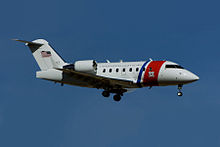 USCG VC-143 Challenger provides VIP transport for high-ranking members of the Department of Homeland Security and U.S. Coast Guard using the designation Coast Guard 02.
USCG VC-143 Challenger provides VIP transport for high-ranking members of the Department of Homeland Security and U.S. Coast Guard using the designation Coast Guard 02.
The Coast Guard operates about 210 aircraft from Air Stations throughout the continental U.S, Alaska, Hawaii, and Puerto Rico. U.S. Coast Guard aviators receive Primary (fixed-wing) and Advanced (fixed or rotary-wing) flight training with their Navy and Marine counterparts at NAS Pensacola, FL, NAS Whiting Field, FL, and NAS Corpus Christi, TX and are considered Naval Aviators. After receiving Naval Aviator Wings, Coast Guard pilots report to USCG Aviation Training Center Mobile, Alabama to receive 6–12 weeks of specialized training in the Coast Guard fleet aircraft they will operate.
Fixed-wing aircraft operate from Air Stations on long-duration missions. Helicopters operate from Air Stations and can deploy on a number of different cutters. Helicopters can rescue people or intercept vessels smuggling migrants or narcotics. Since the terrorist attacks of September 11, 2001, the Coast Guard has developed a more prominent role in national security and now has armed helicopters operating in high risk areas for the purpose of maritime law enforcement and anti-terrorism.
The Coast Guard is now developing a UAV program which will utilize the Predator and Fire Scout UAV platforms for homeland security and search/rescue operations.
Fixed-Wing Aircraft:
- Lockheed HC-130 H/J Hercules
- CASA HC-144A Ocean Sentry
- Dassault HU-25 A/C Guardian [34]
Rotary-Wing Aircraft:
- Sikorsky HH / MH-60 J/T Jayhawk [35]
- Aérospatiale HH / MH-65 C/D Dolphin
Fixed-Wing VIP Transport Aircraft assigned to CGAS Washington D.C:
In 2010 costs per hour (for a search, for example) were $6,530 for a HH-60 helicopter, $7,648 for a HC-130J turboprop, $5,731 for a HU-25D twin jet plane, and $1,171 for a 47-foot lifeboat and response boat.[36]
Boats
The Coast Guard operates about 1,400 boats, defined as any vessel less than 65 feet (20 meters) long, which generally operate near shore and on inland waterways.
The Coast Guard boat fleet includes:
- 47' Motor Life Boat (MLB): The Coast Guard's primary heavy-weather boat used for search and rescue as well as law enforcement and homeland security.
- 45' Response Boat-Medium (RB-M): A new multi-mission vessel intended to replace the 41-foot utility boat.
- 42' Special Purpose Craft – Near Shore Lifeboat : Only two built. Shallow draft substituted for the 47 footer, based at Chatham, MA. SAFE BOAT 42' Hamilton jet driven Near Shore Lifeboat[37]
- 41' Utility Boat (UTB): A general purpose boat used for nearly all Coast Guard missions.
- 36' Long Range Interceptor (LRI): A high-speed launch that can be launched from the rear ramps of the larger Deepwater cutters.
- Aids to Navigation Boats (TANB/BUSL/ANB/ANB): Various designs ranging from 26 to 55 feet used to maintain aids to navigation.
- 33' Special Purpose Craft – Law Enforcement (SPC-LE): Intended to operate in support of specialized law enforcement missions, utilizing three 300 horsepower (220 kW) Mercury Marine engines. The SPC-LE is capable of speeds in excess of 50 knots and operations more than 30 miles from shore.
- 25' Response Boat-Small (RB-S): A high speed boat, for a variety of missions, including search and rescue, port security and law enforcement duties.
- 25' Transportable Port Security Boat (TPSB): A well-armed boat used by Port Security Units for force protection.
- 24' SPC-SW Special Purpose Craft, Shallow-water:
- 23' Over-the-Horizon (OTH) boat: A rigid hull inflatable boat used by medium and high endurance cutters and specialized units.
- 23' Short Range Prosecutor (SRP): A rigid hull inflatable boat that can be launched from a rear launching ramp on the National Security Cutters.
Weapons
The Coast Guard uses a wide variety of Weapons. Assault Rifle, shotguns, and sidearm pistols are used to arm boat crew and boarding team members and machine guns are mounted aboard cutters, boats, and helicopters. Snipers are used from helicopters for fire support and to shoot engines on fast boats that try to outrun the coast guard maritime.
Weapons Include:
- M16A2 rifle
- M4 carbine
- M14 EBR Scoped
- HK416
- MP5
- Beretta 92 Pistol
- SIG Sauer P229R DAK .40 S&W pistol
- M9 pistol
- Remington M870P 12 gauge shotgun
- Franchi SPAS-12
- FN M240 machine gun
- M2 heavy machine gun
- M39 EMR sniper rifle
- Barrett M82 .50cal sniper rifle
Units within the Deployable Operations Group also employ specialized weapons including the Mk 18 carbine, Mk 11 precision rifle, and M203 grenade launcher. The Helicopter Interdiction Tactical Squadron uses a variant of the Barrett M107 .50-caliber rifle to disable the engines on fleeing boats.Symbols
Core values
The Coast Guard, like the other armed services of the United States, has a set of core values which serve as basic ethical guidelines for all Coast Guard Active Duty, Reservists, Auxiliarists and Civilians. The Coast Guard Core Values are:
- Honor: Integrity is our standard. We demonstrate uncompromising ethical conduct and moral behavior in all of our personal actions. We are loyal and accountable to the public trust.
- Respect: We value our diverse workforce. We treat each other with fairness, dignity and compassion. We encourage individual opportunity and growth. We encourage creativity through empowerment. We work as a team.
- Devotion to Duty: We are professionals, military and civilian, who seek responsibility, accept accountability, and are committed to the successful achievement of our organizational goals. We exist to serve. We serve with pride.[38]
The Guardian Ethos
In 2008, the Coast Guard introduced the Guardian Ethos. As the Commandant, Admiral Allen noted in a message to all members of the Coast Guard: "[T]he Ethos ... defines the essence of the Coast Guard and could be viewed as the contract the Coast Guard and its members make with the nation and its citizens.[39] The Ethos is as follows:
- I am America’s Maritime Guardian.
- I serve the citizens of the United States.
- I will protect them.
- I will defend them.
- I will save them.
- I am their Shield.
- For them I am Semper Paratus.
- I live the Coast Guard Core Values.
- I am a Guardian.
- We are the United States Coast Guard.
Creed of the United States Coast Guardsman
The Creed of the United States Coast Guardsman was written by Vice Admiral Harry G. Hamlet, who served as Commandant of the Coast Guard from 1932 to 1936.[40][41]
- I am proud to be a United States Coast Guardsman.
- I revere that long line of expert seamen who by their devotion to duty and sacrifice of self have made it possible for me to be a member of a service honored and respected, in peace and in war, throughout the world.
- I never, by word or deed, will bring reproach upon the fair name of my service, nor permit others to do so unchallenged.
- I will cheerfully and willingly obey all lawful orders.
- I will always be on time to relieve, and shall endeavor to do more, rather than less, than my share.
- I will always be at my station, alert and attending to my duties.
- I shall, so far as I am able, bring to my seniors solutions, not problems.
- I shall live joyously, but always with due regard for the rights and privileges of others.
- I shall endeavor to be a model citizen in the community in which I live.
- I shall sell life dearly to an enemy of my country, but give it freely to rescue those in peril.
- With God’s help, I shall endeavor to be one of His noblest Works...
- A UNITED STATES COAST GUARDSMAN.
Coast Guard Ensign
The Coast Guard Ensign (flag) was first flown by the Revenue Cutter Service in 1799 to distinguish revenue cutters from merchant ships. The order stated the Ensign would be "sixteen perpendicular stripes (for the number of states in the United States at the time), alternate red and white, the union of the ensign to be the arms of the United States in a dark blue on a white field."[42]
This ensign became familiar in American waters and served as the sign of authority for the Revenue Cutter Service until the early 20th century. The ensign was originally intended to be flown only on revenue cutters and boats connected with the Customs Service but over the years it was found flying atop custom houses as well, and the practice became a requirement in 1874. On 7 June 1910, President William Howard Taft issued an Executive Order adding an emblem to (or "defacing") the ensign flown by the Revenue cutters to distinguish it from what is now called the Customs Ensign flown from the custom houses. The emblem was changed to the official seal of the U.S. Coast Guard in 1927.[43][44]
The purpose of the ensign is to allow ship captains to easily recognize those vessels having legal authority to stop and board them. It is flown only as a symbol of law enforcement authority and is never carried as a parade standard.[45]
Coast Guard Standard
The Coast Guard Standard is used in parades and carries the battle honors of the U.S. Coast Guard. It was derived from the jack of the Coast Guard ensign which used to fly from the stern of revenue cutters. The emblem is a blue eagle from the coat of arms of the United States on a white field. Above the eagle are the words "UNITED STATES COAST GUARD" below the eagle is the motto, "SEMPER PARATUS" and the inscription "1790."
Racing Stripe
The Racing Stripe, officially known as the Service Mark, was designed in 1964 by the industrial design office of Raymond Loewy Associates to give the Coast Guard a distinctive, modern image. First used in 1967, it consists of a narrow blue stripe, a narrow white stripe between, and a broad CG red bar with the Coast Guard shield centered.[46][47][48] The stripes are canted at a 64 degree angle, coincidentally the year the Racing Stripe was designed.[49] The racing stripe is borne by U.S. Coast Guard cutters, aircraft, and many boats. Red-hulled icebreaker cutters bear a narrow white bar, a narrow blue bar, and broad white bar, with the Coast Guard shield centered. Conversely, black-hulled cutters (such as buoy tenders and inland construction tenders) use the standard racing stripe. Auxiliary vessels maintained by the Coast Guard also carry the Racing Stripe, but in inverted colors (i.e., broad blue stripe over narrow white and CG red stripes) and the Auxiliary shield.
Similar Racing Stripe designs have been adopted for the use of other coast guards and maritime authorities, such as the Canadian Coast Guard, the Italian Guardia Costiera, the French Maritime Gendarmerie, the Indian Coast Guard, the German Federal Coast Guard, the Philippine Coast Guard, the Netherlands Coastguard, the European Maritime Safety Agency, the Australian Customs Service, and many other law enforcement and rescue agencies.
Semper Paratus
The official march of the Coast Guard is "Semper Paratus" (Latin for "Always Ready"; Click for audio clip).
Uniforms
Prior to 1972, U.S. Coast Guard personnel wore the same uniforms as the U.S. Navy with distinctive Coast Guard insignia, primarily distinctive cap devices for officers and chief petty officers, incorporation of the Coast Guard shield in lieu of line or staff corps insignia for officers, and different buttons on dress uniforms.
In 1972, the current Coast Guard "Service Dress Blue" (SDB) uniform was introduced for wear by both officers and enlisted personnel; the transition was completed during 1974. The uniform consists of a blue four-pocket single breasted jacket and trousers. A light-blue button-up shirt with a pointed collar, two front button-flap pockets, and shoulder loops, along with a tie of the same shade as the jacket are worn with the uniform. Officer rank insignia parallels that of the U.S. Navy but with the gold Navy "line" star being replaced with the gold Coast Guard Shield and with the Navy blue background color replaced by Coast Guard blue. Enlisted rank insignia is also similar to the Navy with the Coast Guard shield replacing the eagle on collar and cap devices. Group Rate marks (stripes) for junior enlisted members (E-3 and below) also follow U. S. Navy convention with white for seaman, red for fireman, and green for airman. In a departure from the U. S. Navy conventions, all Petty Officers E-6 and below wear red chevrons and all Chief Petty Officers wear gold. Unlike the U.S. Navy, there are no khaki uniforms, and all personnel wear the same color uniform.[50]
The SDB uniform may be worn year-round for business within the Coast Guard and for social occasions where the civilian equivalent is coat and tie.[51]
The "Tropical Blue" variation, worn in warm weather, omits the jacket and tie, and features a short sleeve shirt with rank insignia on shoulder boards for officers, and pin-on collar insignia for Petty Officers. The Tropical Blue uniform may be worn year-round for general office wear and for visits between commands. It may be worn in lieu of the SDB uniform, but not to functions where civilian dress is coat and tie.[51]
Coast Guard officers also have a "Dress White" uniform, nearly identical to the "choker white" uniform worn by naval officers (aside from service-specific insignia and sword design), typically used for formal parade and change-of-command ceremonies. For similar occasions enlisted members wear either Service Dress Blue or Full Dress Blue. Full Dress Blue replaces the light blue shirt with a white shirt, and full size medals are worn on the jacket. A white belt may be worn for honor guards. Mess dress uniforms are worn by members for formal (black tie) evening ceremonies. Like the officers' Dress White uniform, the mess dress uniforms are identical to those of the U.S. Navy, aside from Coast Guard-specific insignia.
The current working uniform of the Coast Guard is the Operational Dress Uniform (ODU). The ODU may be worn year-round primarily as a field utility and watchstanding uniform, and may be worn in an office environment. The ODU is similar to the Battle Dress Uniform of other armed services, both in function and style. However, the ODU is in a solid dark blue with no camouflage pattern and does not have lower pockets on the blouse. The first generation ODU, wearable until July 1, 2012 is worn tucked in. The second generation ODU is worn untucked and has black Coast Guard insignias embroidered on the left shirt pocket as well as the side pockets of the trousers. The ODU is worn with composite-toed boots in most circumstances, but low-cut brown boat shoes may be prescribed for certain vessel boarding operations. A standard baseball-style ball cap is worn, embroidered in gold block lettering with "U.S. Coast Guard." Units may also additionally authorize ball caps with the unit name embroidered for wear while on the unit. A foul weather parka is the outerwear worn with the ODU. The former dark blue working uniform has been withdrawn from use by the Coast Guard but may be worn by Auxiliarists until no longer serviceable.
Coast Guard personnel serving in expeditionary combat units such as Port Security Units, Law Enforcement Detachments, and others, wear the Camouflage Utility Uniform (CUU) with the woodland or desert pattern/color scheme based on the operational commander's guidance. An eight-point cap is worn with rank insignia. The camouflaged utility sun hat may be worn when prescribed by the operational commander, without rank insignia.
All Coast Guardsmen wear the combination cap with all uniforms except the ODU and CUU. Company commanders (the Coast Guard's equivalent of drill sergeants) at Training Center Cape May wear the traditional "Smokey Bear" campaign hat.
A 2006 issuePDF (27 MB) of the Reservist magazine was devoted to a detailed and easy to understand graphical description of all the uniforms displayed as prescribed at that time.
Issues
The Coast Guard faces several issues in the near future.
Lack of coverage affects many areas with high maritime traffic. For example, local officials in Scituate, Massachusetts, have complained that there is no permanent Coast Guard station, and the presence of the Coast Guard in winter is vital. One reason for this lack of coverage is the relatively high cost of building storm-proof buildings on coastal property; the Cape Hatteras station was abandoned in 2005 after winter storms wiped out the 12-foot (3.7 m) sand dune serving as its protection from the ocean. Faced with these issues the Coast Guard has contracted with General Dynamics C4 System to provide a complete replacement of their 1970s era radio equipment. Rescue 21 is the United States Coast Guard's advanced command, control and communications system. Created to improve the ability to assist mariners in distress and save lives and property at sea, the system is currently being installed in stages across the United States. The nation's existing maritime search and rescue (SAR) communications system has been in operation since the early 1970s. Difficult to maintain, increasingly unreliable and prone to coverage gaps, this antiquated system no longer meets the safety needs of America's growing marine traffic. In addition, it is incapable of supporting the Coast Guard's new mission requirements for homeland security, which require close cooperation with Department of Defense agencies as well as federal, state and local law enforcement authorities. Modernizing this system enhances the safety and protection of America's waterways.
Lack of strength to meet its assigned missions is being met by a legislated increase in authorized strength from 39,000 to 45,000. In addition, the volunteer Auxiliary acts as an air and surface resource in support of a variety of missions conducted by Coast Guard units.
Aging vessels are another problem, with the Coast Guard still operating some of the oldest naval vessels in the world. In 2005, the Coast Guard terminated contracts to upgrade the 110-foot (33.5 m) Island Class Cutters to 123-foot (37 m) cutters because of warping and distortion of the hulls. In late 2006, Admiral Thad Allen, Commandant of the Coast Guard, decommissioned all eight 123-foot (37 m) cutters due to dangerous conditions created by the lengthening of the hull- to include compromised watertight integrity. The Coast Guard has, as a result of the failed 110 ft (34 m) conversion, revised production schedules for the Fast Response Cutter (FRC). Of the navies and coast guards of the world's 40 largest navies, the U.S. Coast Guard has the 38th oldest surface fleet.[52]
Live fire exercises by Coast Guard boat and cutter crews in the U.S. waters of the Great Lakes attracted attention in the U.S. and Canada. The Coast Guard had proposed the establishment of 34 locations around the Great Lakes where live fire training using vessel-mounted machine guns were to be conducted periodically throughout the year. The Coast Guard said that these exercises are a critical part of proper crew training in support of the service's multiple missions on the Great Lakes, including law enforcement and anti-terrorism. Those that raised concerns about the firing exercises commented about safety concerns and that the impact on commercial shipping, tourism, recreational boating and the environment may be greater than what the Coast Guard had stated. The Coast Guard took public comment and conducted a series of nine public meetings on this issue. After receiving more than 1,000 comments, mostly opposing the Coast Guard's plan, the Coast Guard announced that they were withdrawing their proposal for target practice on the Great Lakes, although a revised proposal may be made in the future.[53][54][55][56][57]
Deployable Operations Group
The Deployable Operations Group (DOG) is a Coast Guard command established in July 2007. The DOG established a single command authority to rapidly provide the Coast Guard, Department of Homeland Security, Department of Defense, Department of Justice and other interagency operational commanders adaptive force packages drawn from the U.S. Coast Guard's deployable specialized force units.
The planning for the unit began after the terrorist attacks of 11 September 2001, and culminated with its formation on 20 July 2007. Its missions include maritime law enforcement, anti-terrorism, port security, pollution response, and diving operations.
There are over twenty-five specialized units within the Deployable Operations Group including the Maritime Security Response Team (MSRT), Maritime Safety & Security Teams (MSST), Tactical Law Enforcement Teams (TACLET), Port Security Units (PSU), the National Strike Force (NSF), and Regional Dive Lockers. The DOG also manages Coast Guard personnel assigned to the Navy Expeditionary Combat Command (NECC) and is involved in the selection of Coast Guard candidates to attend Navy BUD/S and serve with U.S. Navy SEAL Teams.[58]
Coast Guard Reserve
The United States Coast Guard Reserve is the reserve military force of the Coast Guard.[59] The Coast Guard Reserve was founded on 19 February 1941. Coast Guard reservists normally drill two days a month and an additional twelve days of active duty each year. Coast Guard reservists possess the same training and qualifications as their active duty counterparts, and as such, can be found augmenting active duty Coast Guard units every day.
During the Vietnam War and shortly thereafter, the Coast Guard considered abandoning the reserve program, but the force was instead reoriented into force augmentation, where its principal focus was not just reserve operations, but to add to the readiness and mission execution of every day active duty personnel.
Since 11 September 2001, over 8,500 reservists have been activated and served on tours of active duty, to include deployments to the Persian Gulf and also as parts of Department of Defense combatant commands such as the U.S. Northern Command and Central Command. Coast Guard Port Security Units are entirely staffed with reservists, except for five to seven active duty personnel. Additionally, most of the staffing the Coast Guard provides to the Navy Expeditionary Combat Command are reservists.
The Reserve is managed by the Acting Director of Reserve and Leadership (CG-13), RDML David R. Callahan.
Coast Guard Auxiliary
The United States Coast Guard Auxiliary is the uniformed volunteer component of the Coast Guard, established on 23 June 1939 by an act of Congress as the United States Coast Guard Reserve, it was re-designated as the Auxiliary on 19 February 1941. It works within the Coast Guard in carrying out its noncombatant and non-law enforcement missions.[60] Auxiliarists are subject to direction from the Commandant of the Coast Guard making them unique among all federal volunteers (e.g. Air Force's Civil Air Patrol and FBI's Infragard). As of May 2010, there were approximately 30,000 active Auxiliarists.[61] The Coast Guard has assigned primary responsibility for many recreational boating safety tasks to the Auxiliary, including public boating safety education and voluntary vessel safety checks.
Prior to 1997, Auxiliarists were limited to those tasks and on-water patrols supporting recreational boating safety. In 1997, however, new legislation authorized the Auxiliary to participate in any and all Coast Guard missions except direct military and direct law enforcement.[62] Auxiliarists may support the law enforcement mission of the Coast Guard but may not directly participate in it, and Auxiliarists and their vessels are not permitted to carry a weapon while serving in any Auxiliary capacity. Auxiliarists use their own vessel (e.g., boats, aircraft, and vehicles), once it is registered as a Coast Guard Facility, in Coast Guard missions.
Medals and honors
One Coast Guardsman, Douglas Albert Munro, has earned the Medal of Honor, the highest military award of the United States.[63] Fifty five Coast Guardsmen have earned the Navy Cross and numerous men and women have earned the Distinguished Flying Cross.
The highest peacetime decoration awarded within the Coast Guard is the Homeland Security Distinguished Service Medal; prior to the transfer of the Coast Guard to the Department of Homeland Security, the highest peacetime decoration was the Department of Transportation Distinguished Service Medal. The highest unit award available is the Presidential Unit Citation.
In wartime, members of the Coast Guard are eligible to receive the U.S. Navy version of the Medal of Honor. A Coast Guard Medal of Honor is authorized but has not yet been developed or issued.
In May 2006, at the Change of Command ceremony when Admiral Thad Allen took over as Commandant, President George W. Bush awarded the entire Coast Guard, including the Coast Guard Auxiliary, the Coast Guard Presidential Unit Citation with hurricane device, for its efforts during and after Hurricanes Katrina and Rita.
Organizations
Ancient Order of the Pterodactyl
Those who have piloted or flown in U.S. Coast Guard aircraft under official flight orders may join the Ancient Order of the Pterodactyl ("Flying Since the World was Flat").
The Ancient Albatross Award is presented to the active duty USCG member who qualified as an aviator earlier than any other person who is still serving. Separate enlisted and officer awards are given.[64][65]
Coast Guard CW Operators Association
The Coast Guard CW Operators Association (CGCWOA) is a membership organization comprising primarily former members of the United States Coast Guard who held the enlisted rating of Radioman (RM) or Telecommunications Specialist (TC), and who employed International Morse Code (CW) in their routine communications duties on Coast Guard cutters and at shore stations.[66]
USCG Chief Petty Officers Association
Members of this organization unite to assist members and dependents in need, assist with Coast Guard recruiting efforts, support the aims and goals of the Coast Guard Chief Petty Officers Academy, keep informed on Coast Guard matters, and assemble for social amenities; and include Chief, Senior Chief, and Master Chief Petty Officers, active, reserve and retired. Membership is also open to all Chief Warrant Officers and Officers who have served as a Chief Petty Officer.[67]
Notable Coast Guardsmen
Numerous celebrities have served in the Coast Guard including tennis player Jack Kramer, golfer Arnold Palmer, All Star baseball player Sid Gordon, boxer Jack Dempsey, musicians Kai Winding, Rudy Vallee, Derroll Adams, and Tom Waits, actors Buddy Ebsen, Sid Caesar, Victor Mature, Richard Cromwell, Alan Hale, Jr., William Hopper, Jeff Bridges, Cesar Romero and author Alex Haley.
Vice Admiral Thad Allen in 2005 was named Principal Federal Officer to oversee recovery efforts in the Gulf Region after Hurricane Katrina. After promotion to Admiral, on the eve of his retirement as Commandant, Allen again received national visibility after being named National Incident Commander overseeing the response efforts of the Deepwater Horizon disaster (aka "BP oil disaster).
Former Coast Guard officers have been appointed to numerous civilian government offices. After retiring as Commandant of the Coast Guard in 2002, Admiral James Loy went on to serve as administrator of the Transportation Security Administration and later as Deputy Secretary of the Department of Homeland Security. Admiral Loy was by no means the only Coast Guard officer who was later appointed to a civilian government position; following his Coast Guard career, Carlton Skinner served as the first Civilian Governor of Guam, G. William Miller, 65th Secretary of the Treasury was a graduate of the Coast Guard Academy, and retired Vice Admiral Harvey E. Johnson, Jr. served as Deputy Administrator and Chief Operating Officer of the Federal Emergency Management Agency (FEMA) under President George W. Bush. Rear Admiral Stephen W. Rochon was appointed by President George W. Bush to serve as the Director of the Executive Residence and White House Chief Usher, beginning service on March 12, 2007, and continues to serve in the same capacity under President Barack Obama.
Two Coast Guard aviators, Commander Bruce E. Melnick and Captain Daniel C. Burbank, have served as NASA astronauts.
Popular culture
In gaming
- The 2005 survival horror video game, Cold Fear, depicts a Coast Guardsman investigating paranormal events aboard a Russian whaling ship.
In literature
- A Coast Guard cutter and its commanding officer and crew figured prominently in Tom Clancy's books Clear and Present Danger, Without Remorse, and Executive Orders.
- Sinbad, a dog serving aboard the cutter USCGC Campbell in WWII, who was enlisted and held the rank of Chief Petty Officer, was the first member of the United States Coast Guard to be the subject of a biography in George Foley's Sinbad of the Coast Guard in 1945.
Onscreen, in film
- A 1957 comedy, Onionhead, portrayed Andy Griffith as a Coast Guard recruit.
- The 1966 film Assault on a Queen, starring Frank Sinatra and Verna Lisi, featured USCGC Androscoggin in the film.
- The main character (Ensign Tom Garland, played by Robert Morse) in the 1970 Disney comedy film, The Boatniks, was commander of a small cutter on the West Coast.
- The 1987 comedy, Overboard, features a Coast Guard cutter and crew intercepting a private yacht.
- The 2000 film The Perfect Storm depicted the rescue operations of the USCGC Tamaroa as one of its subplots.
- The 2003 film, Bad Boys II, depicts counter-drug helicopters from the Helicopter Interdiction Tactical Squadron (HITRON).
- In the 2005 family comedy Yours, Mine, and Ours, Dennis Quaid plays a fictional U.S. Coast Guard Academy superintendent who marries a character played by Rene Russo and together have 18 children.
- The 2006 film The Guardian, starring Kevin Costner and Ashton Kutcher, was based on the training and operations of Coast Guard Aviation Survival Technicians.
Onscreen, in television
- The Coast Guard has been featured in several television series, including Baywatch, CSI: Miami, Deadliest Catch, Dirty Jobs, Harbor Command, and Miami Vice, as well as in film.
- In the television series Boston Legal, the characters of Allan Shore and Denny Crane, portrayed by James Spader and William Shatner, respectively, join the U.S. Coast Guard Auxiliary.
- Coast Guard was a syndicated television series that aired for three seasons from 1995 to 1997 in the United States as well as overseas, where it was called Sea Rescue. The series followed Coast Guard personnel as they performed their missions.[68]
- Cartoon character Popeye was in the Coast Guard after being a Merchant Mariner. He later joined the Navy.
- Unnamed Coast Guardsmen were featured in a Channel 5 documentary Royal Navy Caribbean Patrol. They were serving aboard HMS Manchester, a British Navy ship combating drug smugglers in the Caribbean.
See also
Coast Guard
- Chaplain of the Coast Guard
- Coast Guard Day
- U.S. Coast Guard Intelligence
- U.S. Coast Guard Investigative Service (CGIS)
- Joint Maritime Training Center
- List of United States Coast Guard cutters
- List of active United States military aircraft
- Maritime Law Enforcement Academy
- MARSEC
- National Data Buoy Center
- National Ice Center
- Patrol Forces Southwest Asia
- U.S. Coast Guard Legal Division
- United States Coast Guard Research & Development Center
Related agencies
- List of United States federal law enforcement agencies
- National Oceanic and Atmospheric Administration Fisheries Office for Law Enforcement
- U.S. Customs and Border Protection
- United States Marine Corps
- United States Maritime Administration
- United States Merchant Marine
- United States Navy
References
- ^ USCG website snapshot
- ^ a b c "Homeland Security Budget-in-Brief Fiscal Year 2009". United States Department of Homeland Security. 2009. p. 53. http://www.dhs.gov/xlibrary/assets/budget_bib-fy2009.pdf. Retrieved 31 January 2010.
- ^ U.S. Coast Guard Heraldry. United States Coast Guard. April 2011. p. 3-1. http://www.uscg.mil/directives/cim/5000-5999/CIM_5200_14A.pdf.
- ^ Coast Guard Official 'Snapshot' webpage
- ^ The Coast Guard Gets It Right Amanda Ripley. TIME. 23 October 2005.
- ^
- ^ National Search and Rescue Plan (USA) 2007
- ^ ¾National Oil and Hazardous Substances Pollution Contingency Plan (USA) 2007
- ^ a b Jim Garamone (17 October 2007). "Sea Services Unveil New Maritime Strategy". Navy News Service. http://www.navy.mil/search/display.asp?story_id=32655. Retrieved 26 May 2008.
- ^ GAO 2006 Report
- ^ GAO 2006 Summary Table
- ^ People v. Booth, ___ N.Y.S.2d ___, 2008 WL 2247068, 2008 N.Y. Slip. Op. 28206 (N.Y. Co.Ct. 2008)
- ^ How the Coast Guard Gets it Right Amanda Ripley. TIME. 23 October 2005.
- ^ Numbered Fleets
- ^ Castro, Melissa; O'Connell, Jonathan (6 January 2009). "Coast Guard renews lease in Buzzard Point". http://washington.bizjournals.com/washington/stories/2009/01/05/daily36.html.
- ^ Federal News Radio 1500 AM: DHS marks new milestone with St. E's campus groundbreaking. Federalnewsradio.com. Retrieved on 2011-02-16.
- ^ "Coast Guardsman, Not Guardian" (pdf). http://www.annapoliscgaux.org/Policies/Coast_Guardsmen.pdf. Retrieved 2011-06-24.
- ^ Title 14 USC Chapter 3
- ^ USCG Uniform Distribution Center
- ^ a b [1] 14 USC 41. Grades and ratings
- ^ a b [2] 37 USC 201. Pay grades: assignment to; general rules
- ^ Graphics. Uscg.mil. Retrieved on 2011-02-16.
- ^ U.S. Coast Guard History. Uscg.mil. Retrieved on 2011-02-16.
- ^ [3][dead link]
- ^ [4][dead link]
- ^ USCG Civilian Careers
- ^ USCG Regulations. Chapter 10. Accessed 11 December 2006.
- ^ 420' WAGB Data Sheet
- ^ 399' WAGB Data Sheet
- ^ USCGC Eagle Data Sheet
- ^ 140' WTGB Data Sheet
- ^ 110' WPB Data Sheet
- ^ 87' WPB Data Sheet
- ^ HU-25 Guardian at GlobalSecurity.org
- ^ HH-60J Jayhawk at GlobalSecurity.org
- ^ Gallop, J.D. (20 November 2010). "Mayday search total bill is $178K". Melbourne, Florida: Florida Today. pp. 1A. http://www.floridatoday.com/article/20101120/NEWS01/11200318/1006/Mayday+search+total+bill+is++178K.
- ^ U.S. Coast Guard Motor Life Boat Station Chatham, MA. Uscg.mil. Retrieved on 2011-02-16.
- ^ United States Coast Guard Core Values
- ^ Guardian Ethos – Coast Guard Training Center Cape May Website
- ^ Harry G. Hamlet – USCG Historian's Office
- ^ USCG History FAQ USCG Historian's Office
- ^ U.S. Coast Guard Flags
- ^ The Coast Guard Ensign, Coast Guard Historian's Office
- ^ The Customs Ensign, Customs Archives
- ^ Coast Guard Ensign (For Release). Cgvi.uscg.mil (1999-06-30). Retrieved on 2011-02-16.
- ^ U.S. Coast Guard Heraldry. United States Coast Guard. April 2011. p. 3-1. http://www.uscg.mil/directives/cim/5000-5999/CIM_5200_14A.pdf. Retrieved 03 May 2011.
- ^ U.S. COAST GUARD COATINGS AND COLOR MANUAL CG-263, 16 July 1973
- ^ Coatings And Color Manual. (PDF) . Retrieved on 2011-02-16.
- ^ "US Coast Guard History FAQs". US Coast Guard. http://www.uscg.mil/history/faqs/faqs.asp. Retrieved 25 October 2008.
- ^ COMDTINST M1020.6F USCG Uniform Regulations at USCG.mil. Retrieved on 2011-07-27.
- ^ a b ALCOAST 291/11 - Update to USCG Uniform Regulations at USCG.mil. Retrieved on 2011-07-27.
- ^ Defense Technology International, January/February 2007, p26
- ^ http://www.uscgd9safetyzones.com Ninth Coast Guard District – U.S. Great Lakes proposed permanent safety zones information site
- ^ United States Federal Register – 1 August 2006 – Notice of Proposed Rulemaking
- ^ CBC News – 16 October 2006 – U.S. machine-gun fire suspended on Great Lakes
- ^ Columbus Dispatch – 10 September 2006 – Some up in arms over fire zones
- ^ http://www.CitizensForLakeSafety.org Opponents of the Coast Guard's live fire plan
- ^ Coast Guard Expects New Deployable Group Operating By Next Summer
- ^ "United States Code". Cornell Law. http://www.law.cornell.edu/uscode/uscode14/usc_sec_14_00000704----000-.html. Retrieved 4 May 2011.
- ^ US Coast Guard Auxiliary Policy Statement, The Commandant of the US Coast Guard R. J. Papp, Jr.
- ^ USCG snapshot
- ^ 33 CFR 5.31 states that: Members of the Auxiliary, when assigned to specific duties shall, unless otherwise limited by the Commandant, be vested with the same power and authority, in execution of such duties, as members of the regular Coast Guard assigned to similar duties.
- ^ United States Coast Guard. SM1c Douglas Albert Munro, USCG. Accessed 12 May 2010.
- ^ Ancient Albatross Award
- ^ "The Bird That Continues to Fly: A History of the Ancient Albatross Award" by Nora L. Chidlow, USCG Archivist, LinkPDF (1 MB)
- ^ CGCWOA – Official Website
- ^ USCG Chief Petty Officers Association – Official Website
- ^ Film.com – Coast Guard. Retrieved December 25, 2009.
Further reading
- Krietemeyer, George. Coast Guardsman's Manual. Annapolis, Md.: Naval Institute Press, 2000. ISBN 1-55750-468-7.
External links
- U.S. Coast Guard Website
- Reports on the Coast Guard, Department of Homeland Security Office of Inspector General
- 'A Cooperative Strategy for 21st Century Seapower'
- U.S. Coast Guard Videos
- Coast Guard Personnel Locator
- How to join the U.S. Coast Guard
- U.S. Coast Guard Auxiliary Website
- Coast Guard Channel
- Coast Guard News
- Congressional Research Service (CRS) Reports regarding the U.S. Coast Guard
- USCG News
- U S Coast Guard Networked. U S Coast Guard Networked Group on LinkedIn
- America's Waterway Watch
Department of Homeland Security Deputy Secretary United States Coast Guard · Immigration and Customs Enforcement · Citizenship and Immigration Services · Customs and Border Protection · Federal Emergency Management Agency · Federal Law Enforcement Training Center · United States Secret Service · Office of Operations Coordination · Transportation Security Administration
National Protection
and ProgramsFederal Protective Service · National Communications System · National Cyber Security Division · US-VISIT · Infrastructure ProtectionScience and
TechnologyIntelligence and Analysis Management Policy Policy Development · International Affairs · State and Local Law Enforcement · Private Sector · Immigration Statistics · Screening Coordination · Strategic Plans · Homeland Security Advisory CouncilLeadership - Commander-in-chief: President of the United States
- Secretary of Defense
- Deputy Secretary of Defense
- Joint Chiefs of Staff (Chairman)
- United States Congress: Committees on Armed Services:
- Active duty four-star officers
- Highest ranking officers in history
- National Security Act of 1947
- Goldwater–Nichols Act
Organization - Department of Homeland Security (Secretary): Coast Guard
Branches- Army (Chief of Staff)
- Marine Corps (Commandant)
- Navy (Chief of Naval Operations)
- Air Force (Chief of Staff)
- Coast Guard (Commandant)
Reserve componentsStructure - United States Code
- The Pentagon
- Installations
- Budget
- Units:
- Logistics
- Media
Operations and history - Current deployments
- Conflicts
- Wars
- Timeline
- History:
- Colonial
- WWII
- Civil affairs
- African Americans
- Asian Americans
- Jewish Americans
- Sikh Americans
- Historiography:
- Art:
- A
- AF
Personnel TrainingOther- Oath:
- Creeds & Codes:
- Service numbers:
- A
- MC
- N
- AF
- CG
- Military Occupational Specialty/Rating/Air Force Specialty Code
- Pay
- Uniform Code of Military Justice
- Judge Advocate General's Corps
- Military Health System/TRICARE
- Separation
- Veterans Affairs
- Conscription
- Chiefs of Chaplains:
Equipment LandSeaAirOtherLegend: A = Army, MC = Marine Corps, N = Navy, AF = Air Force, CG = Coast Guard, PHS = Public Health Service, NOAA = National Oceanic and Atmospheric Administration, MSC = Military Sealift CommandUnited States (Outline) History Pre-Columbian era · Colonial era (Thirteen Colonies · Colonial American military history) · American Revolution (War) · Federalist Era · War of 1812 · Territorial acquisitions · Territorial evolution · Mexican–American War · Civil War · Reconstruction era · Indian Wars · Gilded Age · African-American Civil Rights Movement (1896–1954) · Spanish–American War · Imperialism · World War I · Roaring Twenties · Great Depression · World War II (Home front) · Cold War · Korean War · Space Race · African-American Civil Rights Movement (1955–1968) · Feminist Movement · Vietnam War · Post-Cold War (1991–present) · War on Terror (War in Afghanistan · Iraq War) · Timeline of modern American conservatismTopicsDemographic · Discoveries · Economic (Debt Ceiling) · Inventions (before 1890 · 1890–1945 · 1946–1991 · after 1991) · Military · Postal · Technological and industrialFederal
governmentLegislature - Congress
Senate
· Vice President
· President pro tem
House of Representatives
· Speaker
Judiciary - Supreme Court
Federal courts
Courts of appeal
District courtsExecutive - President
Executive Office
Cabinet / Executive departments
Civil service
Independent agencies
Law enforcement
Public policy
Intelligence
Central Intelligence Agency
Defense Intelligence Agency
National Security Agency
Federal Bureau of InvestigationPolitics Divisions · Elections (Electoral College) · Foreign policy · Foreign relations · Ideologies · Local governments · Parties (Democratic Party · Republican Party · Third parties) · Political status of Puerto Rico · Red states and blue states · Scandals · State governments · Uncle SamGeography Cities, towns, and villages · Counties · Extreme points · Islands · Mountains (Peaks · Appalachian · Rocky) · National Park System · Regions (Great Plains · Mid-Atlantic · Midwestern · New England · Northwestern · Southern · Southwestern · Pacific · Western) · Rivers (Colorado · Columbia · Mississippi · Missouri · Ohio · Rio Grande) · States · Territory · Water supply and sanitationEconomy Agriculture · Banking · Communications · Companies · Dollar · Energy · Federal Budget · Federal Reserve System · Financial position · Insurance · Mining · Public debt · Taxation · Tourism · Trade · Transportation · Wall StreetSociety TopicsCrime · Demographics · Education · Family structure · Health care · Health insurance · Incarceration · Languages (American English · Spanish · French) · Media · People · Public holidays · Religion · SportsArchitecture · Art · Cinema · Cuisine · Dance · Fashion · Flag · Folklore · Literature · Music · Philosophy · Radio · Television · TheaterIssuesCoast guards Argentina · Aruba · Australia · Bangladesh · Barbados · Belize · Canada · China · Croatia · Cyprus · Egypt · France · Germany · Greece · Haiti · Iceland · India · Ireland · Italy · Japan · South Korea · Malaysia · Maldives · New Zealand · Netherlands · Netherlands (Caribbean) · Norway · Pakistan · Peru · Philippines · Russia · Singapore · Sri Lanka · Sweden · Taiwan · Turkey · Ukraine · United Arab Emirates · United Kingdom · United States of America · VietnamCategories:- 1915 establishments in the United States
- Coast guards
- Gendarmerie
- Organizations based in Washington, D.C.
- Sea rescue organisations
- Uniformed services of the United States
- United States Coast Guard
- United States Department of Homeland Security
Wikimedia Foundation. 2010.

